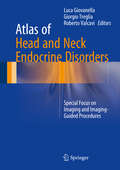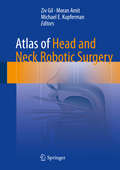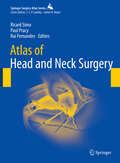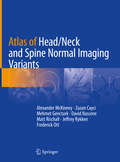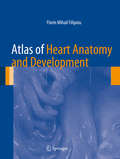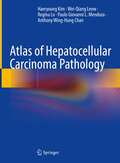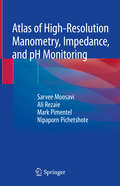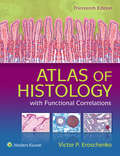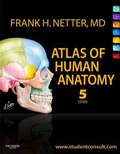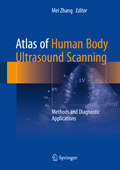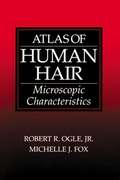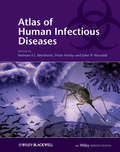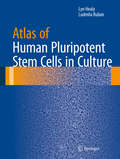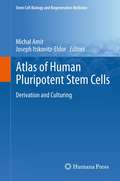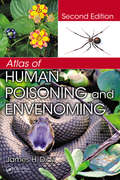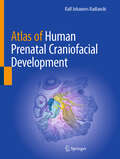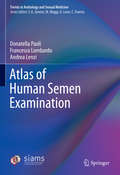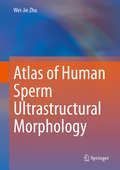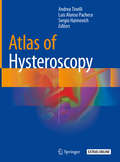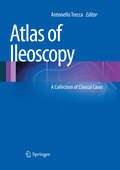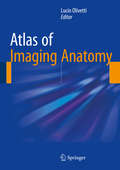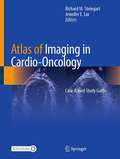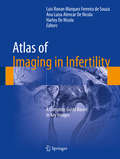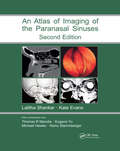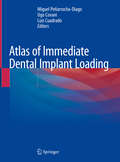- Table View
- List View
Atlas of Head and Neck Endocrine Disorders: Special Focus on Imaging and Imaging-Guided Procedures
by Luca Giovanella Giorgio Treglia Roberto ValcaviThis atlas draws on a multidisciplinary approach to provide a comprehensive overview on endocrine disorders of the head and neck, with particular emphasis on the role of imaging and image-guided procedures. The first section discusses the basic characteristics of the imaging methods and other techniques used for evaluation and diagnosis. The remainder of the book focuses on application of these methods in thyroid, parathyroid, and other endocrine disorders of the head and neck. The coverage is wide ranging, encompassing Graves' disease, toxic multinodular goiter, toxic adenoma, thyroiditis, non-toxic goiter, benign nodules, and the different forms of thyroid carcinoma, as well as parathyroid adenoma, hyperplasia, and carcinoma and paragangliomas. Informative, high-quality images are provided by international experts in endocrine disorders, including endocrinologists, pathologists, radiologists, nuclear medicine physicians, and surgeons, who also discuss sample cases and provide syntheses of the relevant scientific literature.
Atlas of Head and Neck Robotic Surgery
by Ziv Gil Moran Amit Michael E. KupfermanThis atlas offers precise, step-by-step descriptions of robotic surgical techniques in the fields of otolaryngology and head and neck surgery, with the aim of providing surgeons with a comprehensive guide. The coverage encompasses all current indications and the full range of robotic surgical approaches, including transoral, transaxillary, transmaxillary, and transcervical. Key clinical and technical issues and important aspects of surgical anatomy are highlighted, and advice is provided on ancillary topics such as postoperative care and robotic reconstructive surgery. Robotic surgery has proved a significant addition to the armamentarium of tools in otolaryngology and head and neck surgery. It is now used in many centers as the workhorse for resection of oropharyngeal and laryngeal tumors, thyroid surgery, and base of tongue resection in patients with obstructive sleep apnea. The da Vinci robotic system, with its three-dimensional vision system, is also excellent for parapharyngeal, nasopharyngeal, and skull base resections. This superbly illustrated book, with accompanying online videos, will be ideal for residents in otolaryngology-head and neck surgery and skull base surgery who are working in a robotic cadaver lab and for specialists seeking to further improve their dissection techniques.
Atlas of Head and Neck Surgery (Springer Surgery Atlas Series)
by Rui Fernandes Ricard Simo Paul PracyThis atlas aims to provide the reader with comprehensive and structured knowledge of contemporary head and neck surgical procedures in patients with both benign and malignant diseases. The bulk of the atlas is devoted to the surgical management of malignant tumors of the upper aerodigestive tract, with a separate chapter focusing on each major anatomic subsite. All aspects of endoscopy are covered, as is surgery of the upper airway, including tracheostomy, laryngotracheal reconstruction and surgery for vocal cord paralysis. Thorough consideration is also given to procedures for the treatment of carotid body tumors, branchial arch anomalies, deep neck space infections, pharyngeal pouches, and benign disease of the thyroid, parathyroid, and salivary glands. A final chapter addresses in detail the reconstruction of surgical defects in the head and neck. Each chapter includes bespoke drawings and diagrams to illustrate specific technical points and surgical steps. The authors are leading head and neck surgeons from Europe, North America, India, Africa, and Australia. Readers seeking a better understanding of how to carry out surgical procedures in this anatomic region will find the atlas to be an invaluable aid.
Atlas of Head/Neck and Spine Normal Imaging Variants
by Alexander McKinney Zuzan Cayci Mehmet Gencturk David Nascene Matt Rischall Jeffrey Rykken Frederick OttThis text provides a comprehensive overview of the normal variations of the neck, spine, temporal bone and face that may simulate disease. Comprised of seven chapters, this atlas focuses on specific topical variations, among them head-neck variants, orbital variants, sinus, and temporal bone variants, and cervical, thoracic, and lumbar variations of the spine. It also includes comparison cases of diseases that should not be confused with normal variants. Atlas of Head/Neck and Spine Normal Imaging Variants is a much needed resource for a diverse audience, including neuroradiologists, neurosurgeons, neurologists, orthopedists, emergency room physicians, family practitioners, and ENT surgeons, as well as their trainees worldwide.
Atlas of Heart Anatomy and Development
by Florin Mihail FilipoiuThis heart anatomy book describes the cardiac development and cardiac anatomy in the development of the adult heart, and is illustrated by numerous images and examples. It contains 550 images of dissected embryo and adult hearts, obtained through the dissection and photography of 235 hearts. It has been designed to allow the rapid understanding of the key concepts and that everything should be clearly and graphically explained in one book. This is an atlas of cardiac development and anatomy of the human heart which distinguishes itself with the use of 550 images of embryonic, fetal and adult hearts and using text that is logical and concise. All the mentioned anatomical structures are shown with the use of suggestive dissection images to emphasize the details and the overall location. All the images have detailed comments, while clinical implications are suggested. The dissections of different hearts exemplify the variability of the cardiac structures. The electron and optical microscopy images are sharp and provide great fidelity. The arterial molds obtained using methyl methacrylate are illustrative and the pictures use suggestive angles. The dissections were made on human normal and pathological hearts of different ages, increasing the clinical utility of the material contained within.
Atlas of Hepatocellular Carcinoma Pathology
by Haeryoung Kim Wei-Qiang Leow Regina Lo Paulo Giovanni Mendoza Anthony Wing-Hung ChanThis atlas is designed to be a user-friendly bench-side reference for pathology trainees and general pathologists in handling and interpreting specimens of hepatocellular carcinoma. It provides over 550 high-quality gross and microscopic photos focusing on hepatocellular carcinoma and its mimickers, and demonstrating a full range of various histological variants of hepatocellular carcinoma. Introductory text in each chapter summarises salient clinical associations, pathological features, and molecular alterations of different variants of hepatocellular carcinoma. Differentiation between hepatocellular carcinoma and its mimickers is illustrated through various case studies.The authors are nationally and internationally recognized hepatopathologists in the Asian-Pacific regions (Hong Kong, Korea, the Philippines, and Singapore), in which the incidence of hepatocellular carcinoma is high.The authors are nationally and internationally recognized hepatopathologists in the Asian-Pacific regions (Hong Kong, Korea, the Philippines, and Singapore), in which the incidence of hepatocellular carcinoma is high.The authors are nationally and internationally recognized hepatopathologists in the Asian-Pacific regions (Hong Kong, Korea, the Philippines, and Singapore), in which the incidence of hepatocellular carcinoma is high.The authors are nationally and internationally recognized hepatopathologists in the Asian-Pacific regions (Hong Kong, Korea, the Philippines, and Singapore), in which the incidence of hepatocellular carcinoma is high.The authors are nationally and internationally recognized hepatopathologists in the Asian-Pacific regions (Hong Kong, Korea, the Philippines, and Singapore), in which the incidence of hepatocellular carcinoma is high.The authors are nationally and internationally recognized hepatopathologists in the Asian-Pacific regions (Hong Kong, Korea, the Philippines, and Singapore), in which the incidence of hepatocellular carcinoma is high.The authors are nationally and internationally recognized hepatopathologists in the Asian-Pacific regions (Hong Kong, Korea, the Philippines, and Singapore), in which the incidence of hepatocellular carcinoma is high.
Atlas of High-Resolution Manometry, Impedance, and pH Monitoring
by Mark Pimentel Sarvee Moosavi Ali Rezaie Nipaporn PichetshoteThis atlas provides a concise yet comprehensive overview of high-resolution manometry, impedance and pH monitoring. Through instructive text and over 130 high-yield images, the atlas describes the basic principles of esophageal, antroduodenal and anorectal high-resolution manometry, reviews both normal and pathologic findings on manometry, covers technical aspects of pH monitoring and impedance, and outlines advances in equipment, software, and diagnostic guidelines.Written by experts in the field, Atlas of High-Resolution Manometry, Impedance, and pH Monitoring is a valuable resource for gastroenterologists and other clinicians and practitioners who work or are interested in the GI motility field.
Atlas of Histology with Functional Correlations: With Functional Correlations (Point (lippincott Williams And Wilkins) Ser.)
by Victor P. EroschenkoThis thirteenth edition of Atlas of Histology with Functional Correlations (formerly diFiore’s) provides a rich understanding of the basic histology concepts that medical and allied health students need to know.
Atlas of Human Anatomy
by Frank H. NetterAtlas of Human Anatomy uses Frank H. Netter, MD's detailed illustrations to demystify this often intimidating subject, providing a coherent, lasting visual vocabulary for understanding anatomy and how it applies to medicine. This 5th Edition features a stronger clinical focus-with new diagnostic imaging examples-making it easier to correlate anatomy with practice. Student Consult online access includes supplementary learning resources, from additional illustrations to an anatomy dissection guide and more. Netter. It's how you know. See anatomy from a clinical perspective with hundreds of exquisite, hand-painted illustrations created by, and in the tradition of, pre-eminent medical illustrator Frank H. Netter, MD. Join the global community of healthcare professionals who've mastered anatomy the Netter way Expand your study at studentconsult. com, where you'll find a suite of learning aids including selected Netter illustrations, additional clinically-focused illustrations and radiologic images, videos from Netter's 3D Interactive Anatomy, dissection modules, an anatomy dissection guide, multiple-choice review questions, drag-and-drop exercises, clinical pearls, clinical cases, survival guides, surgical procedures, and more. Correlate anatomy with practice through an increased clinical focus, many new diagnostic imaging examples, and bonus clinical illustrations and guides online.
Atlas of Human Body Ultrasound Scanning: Methods and Diagnostic Applications
by Mei ZhangThis atlas describes the diagnosis practice and cases of human body ultrasound. It includes anatomic section, standard scan ultrasonogram of every organ, scanning methods and key points, measurement methods, normal value ranges, and clinical significances of every sections. Providing basic information and fundamental principles of ultrasonic diagnosis, it discusses ultrasound scanning of 14 organs in individual chapters. Each section sonography is accompanied by the scanning method, section structure, measuring method and clinical application. The uniform structure and detailed instructions make this atlas an easy-to-use resource for residents to refer to when they encounter specific ultrasound diagnostic problems.
Atlas of Human Hair: Microscopic Characteristics
by Robert R. Ogle Jr. Michelle J. FoxIt fills a void in the resources available to researchers and practitioners in forensic hair examination by providing photographic archetypes for the microscopic characteristics of human hair and the variates of the characteristics seen in forensic examinations, including curl; color; pigment distribution and density; cortical fusi; and ovoid bodie
Atlas of Human Infectious Diseases
by Peter Horby John P. Woodall Heiman F.L.WertheimThe Atlas of Human Infectious Diseases provides a much needed practical and visual overview of the current distribution and determinants of major infectious diseases of humans. The comprehensive full-color maps show at a glance the areas with reported infections and outbreaks, and are accompanied by a concise summary of key information on the infectious agent and its clinical and epidemiological characteristics. Since infectious diseases are dynamic, the maps are presented in the context of a changing world, and how these changes are influencing the geographical distribution on human infections. This unique atlas: Contains more than 145 high quality full-color maps covering all major human infectious diseases Provides key information on the illustrated infectious diseases Has been compiled and reviewed by an editorial board of infectious disease experts from around the world The result is a concise atlas with a consistent format throughout, where material essential for understanding the global spatial distribution of infectious diseases has been thoughtfully assembled by international experts. Atlas of Human Infectious Diseases is an essential tool for infectious disease specialists, medical microbiologists, virologists, travel medicine specialists, and public health professionals. The Atlas of Human Infectious Diseases is accompanied by a FREE enhanced Wiley Desktop Edition - an interactive digital version of the book with downloadable images and text, highlighting and note-taking facilities, book-marking, cross-referencing, in-text searching, and linking to references and glossary terms.
Atlas of Human Pluripotent Stem Cells in Culture
by Lyn Healy Ludmila RubanThis lavishly-illustrated, authoritative atlas explores the intricate art of culturing human pluripotent stem cells. Twelve chapters - containing more than 280 color illustrations - cover a variety of topics in pluripotent stem cell culturing including mouse and human fibroblasts, human embryonic stem cells and induced pluripotent stem cells, characteristic staining patterns, and abnormal cultures, among others. Atlas of Human Pluripotent Stem Cells in Culture is a comprehensive collection of illustrated techniques complemented by informative and educational captions examining what good quality cells look like and how they behave in various environments. Examples of perfect cultures are compared side-by-side to less-than-perfect and unacceptable examples of human embryonic and induced pluripotent stem cell colonies. This detailed and thorough atlas is an invaluable resource for researchers, teachers, and students who are interested in or working with stem cell culturing.
Atlas of Human Pluripotent Stem Cells: Derivation and Culturing (Stem Cell Biology and Regenerative Medicine)
by Michal Amit Joseph Itskovitz-EldorHuman pluripotent stem cells, including human embryonic stem cells and induced pluripotent stem cells, are a key focus of current biomedical research. The emergence of state of the art culturing techniques is promoting the realization of the full potential of pluripotent stem cells in basic and translational research and in cell-based therapies. This comprehensive and authoritative atlas summarizes more than a decade of experience accumulated by a leading research team in this field. Hands-on step-by-step guidance for the derivation and culturing of human pluripotent stem cells in defined conditions (animal product-free, serum-free, feeder-free) and in non-adhesion suspension culture are provided, as well as methods for examining pluripotency (embryoid body and teratoma formation) and karyotype stability. The Atlas of Human Pluripotent Stem Cells - Derivation and Culturing will serve as a reference and guide to established researchers and those wishing to enter the promising field of pluripotent stem cells.
Atlas of Human Poisoning and Envenoming
by James H. DiazClinicians undergoing competency testing, certification, and periodic recertification are frequently faced with computer-based exams designed to evaluate clinical acumen and judgment. Test questions often include an image or radiograph followed by a vignette of the clinical encounter and a series of questions. Designed to better prepare practitione
Atlas of Human Prenatal Craniofacial Development
by Ralf Johannes RadlanskiThis comprehensive atlas captures the prenatal formation of the human head with precision and detail, helping the reader discover the intricate world of craniofacial development. It serves as both a rich visual reference and a foundation for further research on how molecular signaling shapes the unique features of the craniofacial structure. Authored by a leading researcher with more than four decades in prenatal morphogenesis, this atlas goes beyond existing texts by offering an in-depth look at embryonic head formation through high-quality histology and advanced 3D reconstructions. More than 400 meticulously curated, vivid color images include detailed illustrations and 3D models that trace each crucial stage in the development of the human head's anatomical structures. An invaluable resource for scientists, medical professionals, educators, and anyone studying human development, the Atlas of Human Prenatal Craniofacial Development provides insights that lay the groundwork for understanding not only human morphology but also the roots of congenital anomalies.
Atlas of Human Semen Examination (Trends in Andrology and Sexual Medicine)
by Andrea Lenzi Francesco Lombardo Donatella PaoliThis atlas provides valuable information on crucial aspects of sperm examination as well numerous meaningful color illustrations. It discusses successful evaluation of the sperm morphology and the cellular elements other than spermatozoa, enabling readers to unambiguously interpret seminal cytologic images and compare reports for diagnostic, therapeutic and prognostic purposes. With its extensive collection of colored images, the book is intended as a reference resource for students and technicians in the field of andrology as well as practitioners and clinicians in andrology, urology, pathology, IVF and other ART programs
Atlas of Human Sperm Ultrastructural Morphology
by Wei-Jie ZhuThis atlas provides ultrastructural morphological images of human spermatozoa. Sperm morphology plays an essential role in sperm-oocyte interactions and early embryonic development, and human sperm ultrastructural morphology offers a valuable reference tool for assessing certain etiologies of male infertility and reproductive failure. However, the ultrastructural morphology of human sperm has not been systematically evaluated or thoroughly described in the literature. Using 470 original and unpublished images, the book shows various ultrastructural morphological phenotypes; defects of the sperm head, neck, middle piece, principal piece, and terminal piece; as well as artefacts of sperm ultrastructural morphology and phenomena related to inadequate preparation, demonstrating many sperm phenotypes and surface structural appearances for the first time. As such, it helps researchers and practitioners in andrology, reproductive medicine, and reproductive pathology gain a better understanding of human sperm ultrastructural morphology.
Atlas of Hysteroscopy
by Andrea Tinelli Luis Alonso Pacheco Sergio HaimovichThis book provides a wealth of detailed hysteroscopic images, illustrating the various gynecological pathologies that can be directly diagnosed by hysteroscopy. Providing comprehensive coverage, the book examines each pathology on the basis of concrete images, offering readers support with the diagnostic evaluation. This is especially important when there are recrudescent pathologies, such as TBC, which can often confuse physicians in the context of diagnosis, and with regard to oncological, infectious and infertility issues. Written by prominent experts in the field, this atlas offers an extremely useful and comprehensive tool for all gynecologists, which can support them to overcome any diagnostic doubts and arrive at an accurate diagnosis.
Atlas of Ileoscopy: A Collection of Clinical Cases
by Antonello TreccaThis atlas presents high-quality images of clinical cases of small bowel diseases, with a focus on the importance of terminal ileoscopy as the first step in detecting this group of rare pathologies. Among the conditions covered are celiac disease, inflammatory bowel disease, neoplasms, infections, and pediatric disease. The multidisciplinary approach to the presentation of clinical cases, with contributions from histology, radiology, capsule endoscopy, enteroscopy, and surgery, ensures that the atlas will provide an accurate learning course for beginners and also an effective update for specialists.
Atlas of Imaging Anatomy
by Lucio OlivettiThis book is designed to meet the needs of radiologists and radiographers by clearly depicting the anatomy that is generally visible on imaging studies. It presents the normal appearances on the most frequently used imaging techniques, including conventional radiology, ultrasound, computed tomography, and magnetic resonance imaging. Similarly, all relevant body regions are covered: brain, spine, head and neck, chest, mediastinum and heart, abdomen, gastrointestinal tract, liver, biliary tract, pancreas, urinary tract, and musculoskeletal system. The text accompanying the images describes the normal anatomy in a straightforward way and provides the medical information required in order to understand why we see what we see on diagnostic images. Helpful correlative anatomic illustrations in color have been created by a team of medical illustrators to further facilitate understanding.
Atlas of Imaging in Cardio-Oncology: Case-Based Study Guide
by Richard M. Steingart Jennifer E. LiuThis atlas provides a practically applicable didatic case-based guide to the use of cardiac imaging in patient care during and after cancer therapy. It features detailed information on a variety of imaging modalities, including transesophageal echocardiography, magnetic resonance angiography and positron emission tomography. A range of actual patient presentations are included covering both diagnosis and management during curative and palliative surgery, as well as cancer pharmacotherapy with the use of drugs including Trastuzumab, Anthracycline, Cisplatin and Carboplatin. Topics relevant to survivorship are also described. Atlas of Imaging in Cardio-Oncology enables the reader to develop a deep understanding of how to utilise a variety of imaging modalities used in cardio-oncology in a range of scenarios. It provides a critical and timely resource for the trainee and experienced cardiologist, oncologist and radiologist.
Atlas of Imaging in Infertility: A Complete Guide Based in Key Images
by Luis Ronan Marquez Ferreira de Souza Ana Luisa Alencar De Nicola Harley De NicolaThe present Atlas intends to gather the most frequent findings of alterations that causes infertility, both in male and in female, and how they should be analyzed and described, to serve as a guide for physicians who will ask and will perform these imaging tests. There are a group of professionals that may be interested on further knowledge on infertility, since this is a highly prevalent condition: about 10% of married couples are infertile and males and females are equally affected. These professionals include endocrinologists, gynecologists and urologists. Moreover, these professionals shall make good use of additional tests, in order to properly treat their patients whenever they suspect of or face a case of infertility. Among these tests, the diagnostic imaging exams are essential. Thus, the Atlas of Imaging in Infertility intends to provide such knowledge, allowing physicians of different specialties to a manage of cases of infertility, both in males and in females.
Atlas of Imaging of the Paranasal Sinuses, Second Edition
by Kate Evans, Thomas R. Marotta, Eugene Yu, Michael Hawke and Heinz StammbergerWith color illustrations, the Second Edition of this best-selling guide concentrates on the advances in technology that are now available to the clinical otolaryngologist. This reinforces the book's position as a classic guide, especially to the problems associated with endoscopic sinus surgery.
Atlas of Immediate Dental Implant Loading
by Miguel Peñarrocha-Diago Ugo Covani Luis CuadradoThis atlas, in which a wealth of illustrations are supported by clear explanatory text, offers an up-to-date and comprehensive overview of the immediate restoration of teeth and immediate functional loading when using different implant systems and surfaces in patients with single tooth loss or partial or complete edentulism. It provides guidance on all aspects of technique, including procedures for impression and measurement taking, and describes the surgical and prosthetic protocols applicable in various settings. The coverage encompasses the more advanced techniques used for immediate loading of implants placed in conjunction with grafting/augmentation procedures or in fresh extraction sockets, as well as immediate implant loading for mandibular and maxillary full-arch rehabilitation. This atlas will help dental students and practitioners to gain a sound understanding of immediate loading techniques, including their indications and limitations, and to apply them optimally in their practice. The atlas also shows and explains how to integrate a full digital workflow from the intraoral scanner to solve complex cases in a simple way.
